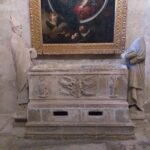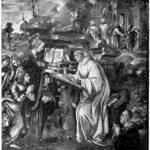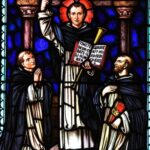St. Leonard
Saint Leonard
Notable World Events During His Time
- 476 AD – Fall of the Roman Empire: In the year 476 AD, the Roman Empire, which had been a dominant force for centuries, finally fell. This marked the end of ancient Rome and the beginning of the Middle Ages, a time of great transformation in Europe.
- 507 AD – Battle of Vouillé: The Battle of Vouillé was a significant event during St. Leonard’s lifetime. It resulted in the defeat of the Visigothic king Alaric II by the Frankish king Clovis I, expanding Frankish influence in the region.
- 570 AD – Birth of Prophet Muhammad: In the year 570 AD, the founder of Islam, Prophet Muhammad, was born in Mecca. His teachings would go on to shape the course of history, and Islam would become one of the world’s major religions.
- 589 AD – Council of Toledo: The Third Council of Toledo, held in 589 AD, played a vital role in the history of Spain. It helped in the conversion of the Visigoths to Catholicism and solidified the position of the Catholic Church in the region.
- 622 AD – The Hijra: This significant event marked the migration of Prophet Muhammad and his followers from Mecca to Medina, known as the Hijra. This event is considered the starting point of the Islamic lunar calendar and was a crucial turning point for Islam.
- 640 AD – Library of Alexandria Destruction: In 640 AD, during St. Leonard’s lifetime, the Library of Alexandria, one of the ancient world’s most renowned centers of knowledge, was tragically destroyed during the Muslim conquest of Egypt, resulting in the loss of countless historical texts and knowledge.
- 732 AD – Battle of Tours: The Battle of Tours, fought in 732 AD, halted the expansion of the Islamic Umayyad Caliphate into Europe. Frankish leader Charles Martel’s victory was crucial in preserving Christianity and European culture.
Patronage: St. Leonard is widely known as the patron saint of prisoners, captives, and women in labor. His life of compassion and intercession for those in distress earned him this role as a protector and helper.
Life and Dedication
Saint Leonard is also known as Leonard of Noblac. Some refer to him as Leonard, Linhart, Leonhard, Leonardo, and even Annard.
Although quite notable in the Roman Catholic Church, there are details missing about the life of Leonard.
Saint Leonard was said to have been a Frankish nobleman. He belonged to the court of King Clovis I, a pagan man who established the Merovingian dynasty.
Saint Leonard was a devoted young Christian. He was said to have been the godchild of Saint Remigius, who was at that time the bishop of Reims.
As soon as he was old enough, Saint Leonard joined his godfather as a disciple. He often accompanied Saint Remigius on his missions to preach the gospel to pagan worshippers.
As a disciple, he was given permission to visit several prisons. There, he would preach to the sinners and set them free if necessary.
In his time, Saint Leonard set quite a few prisoners free.
Legacy
He was an austere man who practiced mortification, prayed, and fasted for long periods. He was zealous and dedicated to God.
It was, therefore, no surprise that he was considered a likely candidate for the bishopric. This offer was exempted for members of the noble Merovingian court.
Saint Leonard turned down the offer, much to the dismay of the parishioners.
At some point in history, the Queen joked with Leonard and insinuated that he used prayers to stop an impending opposition army attack. To her and the rest of the court’s surprise, Saint Leonard prayed to God, and King Clovis I won the battle.
It was this stunning miracle that convinced King Clovis that a pagan God could not help him. He and the rest of the noble court converted to Christianity.
Sometime later, Saint Leonard joined a monastery at Micy, near Orleans, France. There, he dedicated his time to improving his relationship with God.
He might have motivated his brother, Saint Lifiard, to build a monastery at Neun, where he and other young Christian men lived.
Saint Leonard had become used to human interaction. He craved total seclusion, and so he retreated into the forest of Limousin. There, he became a hermit.
He continued to preach to the locals, and soon he had converted many to Christianity. These people will come to respect Saint Leonard as much as they stuck around him for his knowledge.
He was said to have established an oratory. He lived there and only ventured out to preach to the people nearby and in other churches.
The people, however, wanted more of him. For this reason, Saint Leonard founded a monastery that was open to all devoted locals. The monastery was closely located near Leonard’s oratory.
Saint Leonard was said to have performed miracles during his time. The most notable miracle was the delivery of a baby for the Queen of Franks, who suffered from a complicated pregnancy. He was rewarded with several pieces of land at Noble.
On a piece of this land, he established the Abbey of Noblac.
He was revered by many, and he almost always drew crowds of people who came to say their respects.
Death and Canonization
Saint Leonard died around 559 A.D. He received as much respect in his death as he did when he was alive.
His shrine was visited by pilgrims, and he was noted for several miracles. There are about 4000 requests that were granted through the intercession of Saint Leonard.
Saint Leonard is celebrated on the 6th of November. He is venerated in the Roman Catholic Church, the Eastern Orthodox Church, and the Anglican Church.
5 Interesting Facts About Saint Leonard
- Did you know that Saint Leonard is the patron saint of prisoners?
- Did you know that Saint Leonard survived on fruits, herbs, and water
from a spring as a hermit? - Did you know that there are churches dedicated to Saint Leonard in
major cities in France, Belgium, Spain, and Italy? - Did you know the Saint-Léonard-de-Noblat village is named after
Saint Leonard? - Did you know that history records that prisoners egos invoked Saint
Leonard, are you set free from their chains?
Prayer to Saint Leonard
O Almighty God, who has called us to faith in thee and bast compassedus about with so great a cloud of witnesses; Grant that we, encouraged by the good examples of thy saints and especially of thy servant Leonard, may persevere in running the race that is set before us, until at length, through thy mercy, we with them attain to the eternal joy, through him who is the author and finisher of our faith, thy Son Jesus Christ, our Lord. Amen.
Source:[https://www.sainttherse.com/prayer-to-saint-leonard-of-noblac/]{.ul}



